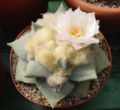Ariocarpus retusus
| Ariocarpus retusus | |
|---|---|

| |
| Scientific classification | |
| Kingdom: | Plantae |
| Clade: | Tracheophytes |
| Clade: | Angiosperms |
| Clade: | Eudicots |
| Order: | Caryophyllales |
| Family: | Cactaceae |
| Subfamily: | Cactoideae |
| Genus: | Ariocarpus |
| Species: | A. retusus
|
| Binomial name | |
| Ariocarpus retusus Scheidw.
| |
| Synonyms | |
|
List
| |
Ariocarpus retusus is a species of cactus, from the genus Ariocarpus, found mainly in Mexico. It is one of the largest and fastest-growing species in this genus known for a slow rate of growth.[2] Despite its slow growth, often taking ten years to reach flowering age, the retusus is a desirable cactus for cultivation, having attractive flowers and an unusual form for a cactus. It is also one of the most easily cultivated species in the genus.
Description
Ariocarpus retusus has flattened, spherical shoots that are gray-green, blue-green, or yellow-green, growing to heights of 3 to 25 centimeters and diameters of 4 to 30 centimeters. The erect, spreading warts protrude from the soil, crowded at the base, and are somewhat pointed or sharp-tipped with rounded or flat tops. The warts measure 1.5 to 4 centimeters long and 1 to 3.5 centimeters wide, sometimes as long as they are wide or twice as long. Occasionally, areoles are present at the tips of the warts. The flowers are cream to light yellow, white (sometimes with a red central stripe), or pinkish red, and have a diameter of 3 to 5 centimeters. The elongated fruits are 1 to 2.5 centimeters long.[3]
The chromosome count is 2n = 22.[4]
-
Large flowering Ariocarpus retusus
-
small flowering plant
-
Plant
-
Areoles
Distribution
Ariocarpus retusus is found in Mexico, from the states of Coahuila and Nuevo León south along both sides of the Sierra Madre Occidental to San Luis Potosí, Tamaulipas, and Zacatecas in the high Chihuahuan desert at elevations between 1300 and 2000 meters. This species grows on limestone and rocky slopes and in grasslands.[5]
-
Plant growing in habitat near Peyote San Luis Potosi
-
Plant growing in habitat near Ranch San Rafael, Nuevo Leon
-
Plant growing on limestone near San Jose De Salamanca, Tamaulipas
Taxonomy
This species was first described in 1838 by Michael Joseph François Scheidweiler, the specific epithet "retusus" comes from Latin, meaning 'blunted,' referring to the shape of the warts.[6]
Pharmacology
Hordenine, N-methyltyramine, N-methyl-3,4-dimethoxy-β-phenethylamine and N-methyl-4-methoxy-β-phenethylamine[7] as well as the flavonol retusin has been found in Ariocarpus retusus.[8] The locals use the slime from the roots of the plants as glue to repair pottery. As a medicinal plant it is used to treat fever. The Huichols use them in religious ceremonies.
References
- ^ "Appendices | CITES". cites.org. Retrieved 2022-01-14.
- ^ "Ariocarpus retusus".
- ^ Anderson, Edward F.; Eggli, Urs (2005). Das grosse Kakteen-Lexikon (in German). Stuttgart (Hohenheim): Ulmer. p. 74. ISBN 3-8001-4573-1.
- ^ Anderson, Edward F. (1960). "A Revision of Ariocarpus (Cactaceae). I. The Status of the Proposed Genus Roseocactus". American Journal of Botany. 47 (7). Botanical Society of America: 582–589. ISSN 0002-9122. JSTOR 2439437. Retrieved 2024-06-15.
- ^ Vallicelli, Valentino (2013-08-04). "Ariocarpus retusus". LLIFLE. Retrieved 2024-06-15.
 This article incorporates text from this source, which is available under the CC BY-SA 3.0 license.
This article incorporates text from this source, which is available under the CC BY-SA 3.0 license.
- ^ Sciences, Mie Royale Des (1838). "Bulletins de l'Académie royale des sciences, des lettres et des beaux-arts de Belgique". Biodiversity Heritage Library. Retrieved 2024-06-15.
- ^ Braga, D.; McLaughlin, J. (1969). "CACTUS ALKALOIDS V. ISOLATION OF HORDENINE AND N–METHYLTYRAMINE FROM ARIOCARPUS RETUSUS". Planta Medica. 17 (01): 87–94. doi:10.1055/s-0028-1099832. ISSN 0032-0943.
- ^ Domínguez, Xorge; Ramírez, Rafael; Ugaz, Olga; D., Jesús; Ketcham, Roger (1968). "CHEMICAL STUDY OF THE CACTUS ARIOCARPUS RETUSUS". Planta Medica. 16 (02): 182–183. doi:10.1055/s-0028-1099897. ISSN 0032-0943.
External links
 Media related to Ariocarpus retusus at Wikimedia Commons
Media related to Ariocarpus retusus at Wikimedia Commons Data related to Ariocarpus retusus at Wikispecies
Data related to Ariocarpus retusus at Wikispecies
- CS1 German-language sources (de)
- Articles with imported Creative Commons Attribution-ShareAlike 3.0 text
- Articles with short description
- Short description is different from Wikidata
- IUCN Red List least concern species
- Articles with 'species' microformats
- Commons category link is on Wikidata
- Ariocarpus
- Cacti of Mexico
- Endemic flora of Mexico
- Garden plants of North America








